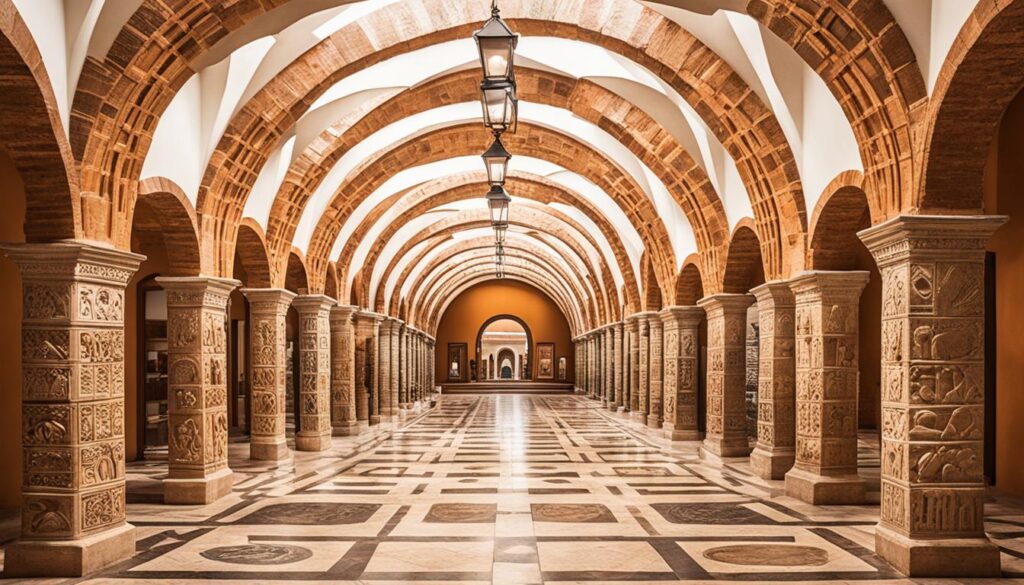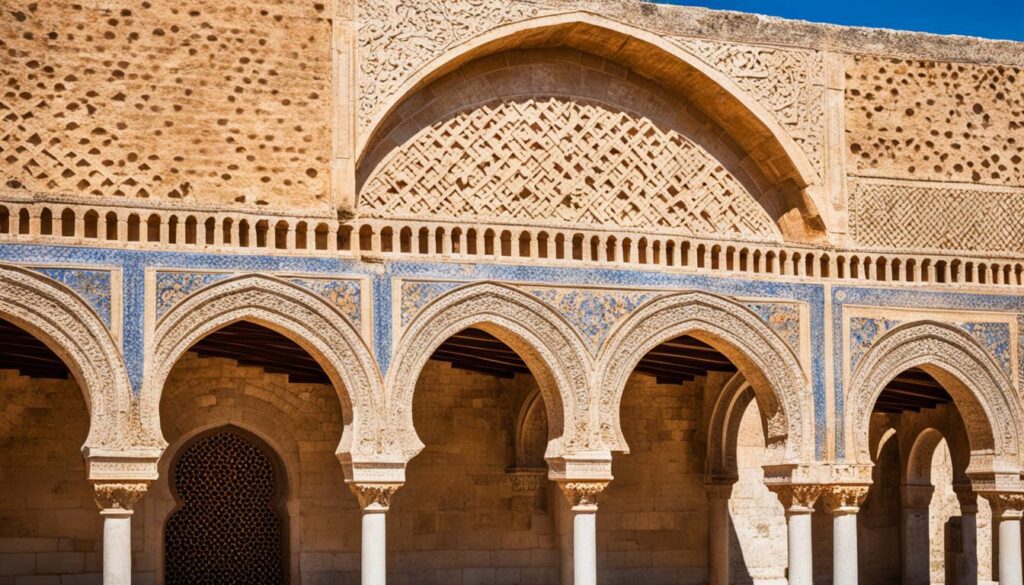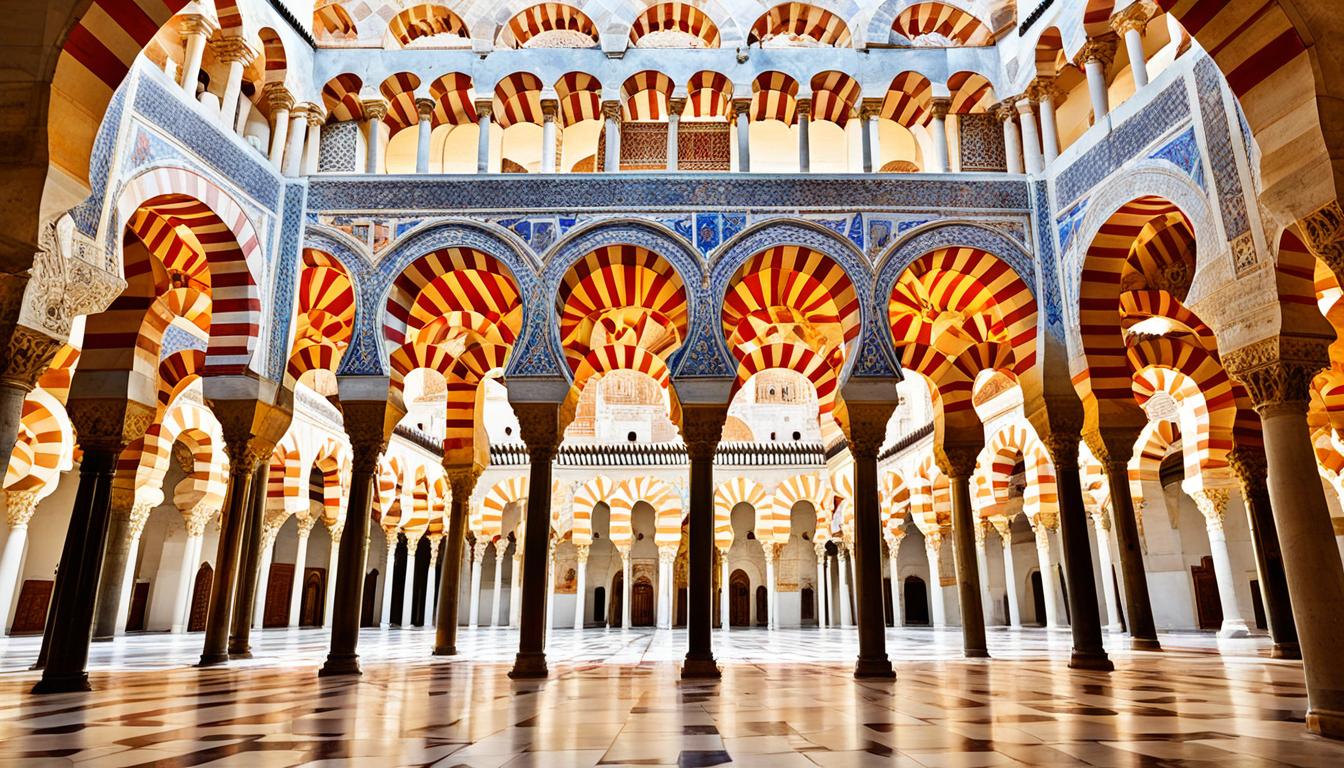Cordoba, Spain, is a city full of history and culture. It’s famous for the Mezquita-Catedral, a beautiful Islamic building. The city also has a lovely Jewish Quarter with narrow streets and beautiful courtyards.
Visitors can see the mix of Moorish, Christian, and Jewish cultures. There are ancient Roman sites to explore. You can also enjoy Andalusian culture by attending festivals, watching flamenco shows, and trying local food.
Key Takeaways
- Cordoba is a city rich in cultural heritage, with influences from Roman, Christian, Islamic, and Jewish civilizations.
- The Mezquita-Catedral, a stunning mosque-cathedral, is a must-see attraction showcasing Cordoba’s Moorish architectural legacy.
- The charming Judería, or Jewish Quarter, features winding streets, flower-filled patios, and the historic Synagogue.
- Cordoba’s vibrant Andalusian culture is celebrated through festivals, flamenco shows, and its renowned local cuisine.
- The city’s ancient Roman monuments, such as the Puente Romano and Calahorra Tower, provide glimpses into Cordoba’s deep historical roots.
Mezquita-Catedral: The Great Mosque of Cordoba
The Mezquita-Catedral, or the Great Mosque of Cordoba, is a top landmark and a UNESCO World Heritage site. It was built in the 8th century. Inside, you’ll find 856 columns and stunning arched entryways. These features highlight the best of Moorish architecture.
Patio de los Naranjos and Prayer Hall
Visitors start at the Patio de los Naranjos (Patio of Oranges), a peaceful courtyard with orange trees. It leads to the prayer hall, a Moorish design masterpiece. Here, you’ll see endless columns and red-and-white arches.
Mihrab Nuevo and Gothic Cathedral Sanctuary
The Mihrab Nuevo, or New Mihrab, is a key feature. It’s a prayer niche made from one piece of marble, filled with beautiful patterns and Quranic verses. This piece contrasts with the Gothic cathedral added later. Together, they show Cordoba’s diverse history.
| Key Facts | Details |
|---|---|
| Total Area | 24,000 square meters |
| Number of Columns | 856 marble and granite columns |
| Original Prayer Hall Capacity | 5,000 worshipers |
| Expanded Prayer Hall Capacity | 9,500 worshipers in 822 AD |
| Tower Height | 54 m (177 ft 2 in) |
| UNESCO World Heritage Designation | 1984 |
| Spanish Cultural Heritage Designation | 1882 |
| Completed as a Cathedral | 1607 |
Judería: Exploring the Old Jewish Quarter
The Judería, or Old Jewish Quarter, is a magical place in Cordoba. It’s filled with narrow streets, whitewashed houses, and patios full of flowers. This area takes you back in time with its Andalusian charm.
Don’t miss the 15th-century Mudéjar-style Synagogue. It’s one of the best-preserved Jewish sites in Spain. Also, visit the Casa de Sefarad museum to learn about the Sephardi people’s history and culture.
Synagogue and Casa de Sefarad
The 14th Century Synagogue of Cordoba is a key spot for those interested in Jewish history. Its Mudéjar design is stunning. Nearby, the Casa de Sefarad is a center for Sephardic Jewish studies. It offers a peek into the traditions of this unique community.
Calleja de las Flores and Zoco Mercado Artesano
The Calleja de las Flores is a sight to behold, with flowers spilling from the buildings. Walking here, you’ll see the Mezquita Bell Tower. For local crafts, head to the Zoco Mercado Municipal Artesano. It’s a place where artisans sell their unique items.
| Attraction | Highlights | Entrance Fee |
|---|---|---|
| Synagogue | 15th-century Mudéjar-style architecture | 3 euros |
| Casa de Sefarad | Museum showcasing Sephardic Jewish history and culture | 3 euros |
| Calleja de las Flores | Iconic, colorful street with views of the Mezquita Bell Tower | Free |
| Zoco Mercado Artesano | Scenic square featuring local artisans and their crafts | Free |
Exploring the Judería is a must for anyone visiting Cordoba, Spain. It’s full of history, beautiful architecture, and vibrant culture. This area truly captures the essence of Cordoba’s charm and diversity.
Alcázar de los Reyes Cristianos: Moorish and Christian Heritage
Cordoba’s Alcázar de los Reyes Cristianos, or Fortress of the Christian Monarchs, is a key piece of history. It was once a Caliphal Palace, home to Moorish rulers. After being conquered by Catholic King Fernando III in 1236, it became a symbol of the city’s rich history.
This site is a mix of Roman, Visigoth, and Moorish styles. It’s a top spot for those who love history and culture.
The Alcázar boasts stunning architecture, like Moorish-era defense walls, towers, and Arabian-style gardens. These gardens feature ornamental pools, hedges, and fountains. You can see Moorish Patio and Roman mosaics inside, showing the site’s cultural depth.
During the Reconquest period, the Alcázar was a key spot for the Catholic Monarchs, Isabella I and Ferdinand II. They planned the capture of Granada from Muslim rule here. Today, it’s a major attraction in Cordoba, covering 55,000 square meters and welcoming many visitors each year.
At the Alcázar, you can check out the Tower of Inquisition and the Royal Baths. These areas highlight the site’s history and design. The gardens are peaceful, with fountains, ponds, and flowers, offering a beautiful experience.
“The Alcázar de los Reyes Cristianos in Córdoba celebrates Spain’s reconquest from Islam back to Christianity in the 13th century.”
The Alcázar is near the Guadalquivir River and the famous Mosque-Cathedral. It’s a key part of Cordoba’s tourist scene. Whether you’re into history, architecture, or just looking for peace, this Moorish and Christian site will impress you.
Fiesta de los Patios de Córdoba: The Courtyard Festival
The Fiesta de los Patios de Córdoba, or the Courtyard Festival, is a colorful event in Córdoba. It happens every year in May. People open their private patios to the public, showing off their beauty.
Visitors can explore charming neighborhoods. They’ll see lush courtyards filled with flowers. These courtyards are decorated with jasmine, citrus blossoms, and Moorish architecture.
The Alcázar Viejo district and Santa Marina are great places to see the best patios. You can also visit around the Iglesia de San Lorenzo and Iglesia de la Magdalena. The Palacio de Viana has 12 beautiful courtyards to see.
The 2024 Fiesta de los Patios de Córdoba is from May 2 to May 12. About 50 patios will be open for visitors.
Some families have been in the Cordoba Patios Festival for years. They pass down their skills and traditions. The Alcazar Viejo district, especially the San Basilio patios, is very popular.
| Key Facts about the Fiesta de los Patios de Córdoba |
|---|
| The festival runs from May 2 to May 12, 2024. |
| Around 50 beautiful patios are open for visiting during the festival. |
| The Alcazar Viejo district, particularly the San Basilio patios, is the most visited area. |
| The festival is recognized by UNESCO as ‘Intangible Cultural Heritage of Humanity’. |
| Guided tours through the Cordoba patios are a popular way to visit the courtyards. |
The Fiesta de los Patios de Córdoba celebrates the tradition of the floral courtyard. It’s recognized by UNESCO as ‘Intangible Cultural Heritage of Humanity’. This is the best time to see the Córdoba patios, as many are open to the public.
Guided tours are a great way to see the patios. They let you visit conveniently and with expert knowledge.
Cordoba Spain must-see: Iconic Attractions
Cordoba is more than just the Mezquita-Catedral and Judería. It has many iconic sights that visitors shouldn’t miss. This Andalusian city is enchanting.
Palacio de Viana and its Stunning Courtyards
The Palacio de Viana is a 15th-century aristocratic palace. It’s famous for its 12 beautiful patios and courtyards. Each courtyard has its own style and charm, with fountains, greenery, and decorations.
Visitors can see original decor, paintings, antique furniture, and tapestries. The palace’s gardens are serene and tranquil.
Puente Romano and Calahorra Tower
The Puente Romano is a key landmark in Cordoba. It’s a 16-arched Roman bridge over the Río Guadalquivir. It was part of the Via Augusta, a major Roman road from Girona to Cádiz.
At the bridge’s southern end is the Calahorra Tower. It’s a Moorish defensive structure from the 14th century. Now, it’s home to the Museo Vivo de Al-Andalus, a museum on Islamic culture and the coexistence of different faiths.
“The Puente Romano, or Roman Bridge, is a remarkable example of ancient engineering still in use today.”
Museo Arqueológico: Tracing Cordoba’s Ancient History
In the heart of Cordoba, Spain, the Museo Arqueológico de Córdoba takes you on an ancient journey. It’s located in the stunning Palacio de los Paez de Castillejo. Here, you can explore Cordoba’s history from its start in the 2nd century BC to its rule by Romans, Visigoths, and Moors.
One key feature is the well-preserved Roman-era amphitheater. It shows how lively Cordoba once was. You can also see homes and shops from the Middle Ages. These give a peek into the daily life of people back then.
The museum has many artifacts and displays that show Cordoba’s deep cultural roots. You’ll see everything from Roman relics to Moorish architecture. It’s a place you can’t miss if you want to learn about Cordoba’s fascinating history.
“The Museo Arqueológico de Córdoba is a treasure trove of Cordoba’s ancient history, showcasing the city’s diverse cultural heritage through an impressive collection of artifacts and exhibits.”

If you love history, architecture, or just want to learn about Cordoba’s past, this museum is for you. It’s a place that will amaze and inspire you.
Exploring the Patios and Alleys of Córdoba
Córdoba is more than just the famous courtyards of the Fiesta de los Patios. It has many beautiful patios and alleys to discover. The Los Patios de San Basilio in the Alcázar Viejo district are a great place to start.
These patios are filled with vibrant flowers, flowing fountains, and Moorish architecture. They offer a peaceful escape from the busy streets. While exploring, look for other charming patios and alleys. Each one has its own special feel and shows the daily life of the people of Córdoba.
Los Patios de San Basilio and Hidden Gems
The Los Patios de San Basilio are a top spot for anyone wanting to see Córdoba’s true spirit. These three beautiful courtyards in the Alcázar Viejo area highlight the city’s Moorish past and patio culture.
- See the vibrant flowers, soothing fountains, and detailed tile work in the patios.
- Find the hidden spots and alleys where locals meet and share stories.
- Take a step back in time and enjoy the peaceful feel of these hidden gems.
While walking through Córdoba, look for more magical patios and alleys. They offer a peek into the city’s deep history and lively culture.
“The patios of Córdoba are like a secret garden, a hidden oasis that invites you to slow down and savor the beauty of the past.”
Day Trips from Cordoba: Medina Azahara and Beyond
Cordoba sits in the heart of Andalusia, perfect for day trips. A top spot is the Medina Azahara, a 10th-century palace-city just five miles west. Once a marvel of Moorish architecture, it’s now a UNESCO site. Visitors can explore ruins and imagine its past glory.
Nature lovers will adore the Parque Natural de las Sierras Subbéticas. This area south of Cordoba is great for hiking and birdwatching. Another must-see is the Castillo de Almodóvar del Río, a medieval castle only 30 minutes away.
| Attraction | Distance from Cordoba | Highlights |
|---|---|---|
| Medina Azahara | 5 miles | UNESCO-listed 10th-century Moorish palace-city |
| Sierras Subbéticas Natural Park | South of Cordoba | Hiking, birdwatching, and whitewashed villages |
| Almodóvar del Río Castle | 30 minutes | Well-preserved medieval castle |
These day trips let you dive into Cordoba’s Moorish past, nature, or history. They’re a great way to learn more about Spain’s rich culture.

“Cordoba’s central location in Andalusia makes it an ideal base for exploring the surrounding region.”
Conclusion: Discovering Cordoba’s Rich Cultural Tapestry
Cordoba is a city where Moorish, Christian, and Jewish cultures blend beautifully. This mix creates a captivating cultural scene that draws in visitors. You’ll find the stunning Mezquita-Catedral, the magical Judería, and ancient Roman sites. Cordoba is full of attractions and experiences that showcase its history.
As you walk through the city, you’ll see different architectural styles and artistic traditions. You’ll also meet diverse communities that have shaped Cordoba over the years. This mix of cultures makes the city’s identity unique.
Visiting Cordoba means marveling at Moorish art, enjoying the beauty of flower-filled patios, and exploring archaeological sites. The city leaves a lasting impression, making you appreciate its cultural legacy more. Cordoba, with its UNESCO-protected historic center, shows how cultural exchange and creativity can last through time.
The city takes you on a journey through history, where old and new meet. You can experience this by enjoying its festivals, trying its famous food, and finding hidden spots. Cordoba is not just a place to visit; it’s a living example of Spain’s cultural richness.

